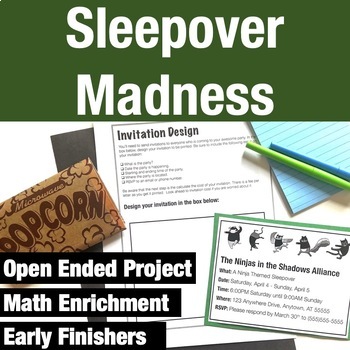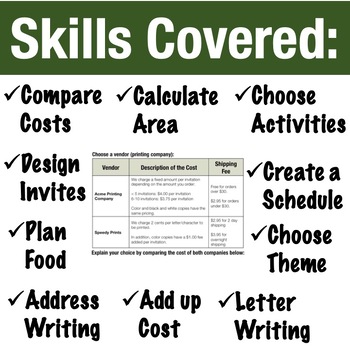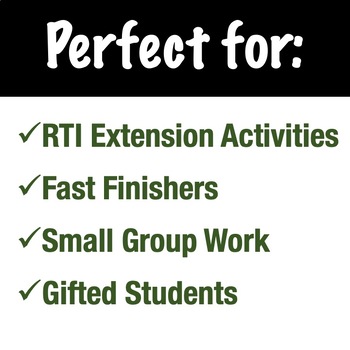Real World Sleepover Math Project for RTI, Enrichment or Early Finishers
- PDF
What educators are saying
Description
Get your fast finisher or enrichment students what they need with the click of your print button. Answer that dreaded question "What do I do when I'm done?" with this resource. This self paced real world math project is perfect for your RTI groups that need enrichment to free you up to work with your most struggling students.
This math project will give your fast finisher elementary students a taste of real world math in the form of a performance task to practice: calculating money, elapsed time, letter writing, address writing, multiplication, addition, area and measurement.
Students will use their problem solving skills and critical thinking in a fun way to plan a sleepover. This is one of those math resources that your students will BEG to do. It's a real-world situation full of authentic tasks.
No more stressing about what to do in your small groups, or for planning a whole class project, or for early finishers. Just save yourself time by printing this project and let them go at it. Students plan all aspects of a sleepover in this open ended performance task! This is an awesome project for students who are in need of enrichment while you reteach other students. This project only requires basic math, but they must use that math in complex ways.
What is in the problem?
There are 11 in-depth problems within this gigantic math task (each step is it's own problem) walking the student through what they need to do. The problems integrate math, reading and writing. It is challenging, open ended, and is a perfect way to practice performance tasks. Everything you need for the problem is included.
Each section is a half or full page of reading to help students practice reading for understanding in math problems. The problems are open ended, meaning that students can come to more than one answer. The problems are deep, multi-step and require perseverance. You will notice that the Standards for Mathematical Practice are embedded within these performance tasks.
What age are the problems appropriate for?
These challenges are appropriate for end of the year 3rd grade (or gifted 3rd graders anytime), 4th grade and possibly for struggling 5th graders.
How can this problem be used?
They could be used as an assessment, test prep, a partner activity, for small group work, as work for students who have finished assignments early or for gifted and talented small groups. Each part of the problem most likely will take more than one class period to complete.
The problem steps and their curricular focus:
1. Who is Invited? They put together an invitation list, including addresses of their friends (address writing- a lost letter writing art!)
2. Theme: They choose a theme for the party and explain their creativity (paragraph writing)
3. Invitation: They design the invitation for the party (invitation writing, dates, addresses, phone numbers)
4. Invitation Cost: They choose between two printers who charge differently (money - dollars or euros, number and operations, multiplication, addition)
5. & 6. Food/Breakfast Time: They choose what meals and food they would serve, using quantity. (money - dollars or euros, number and operations, multiplication, addition)
7. Activities: They get to add plan out what activities they'd like to do and calculate the cost. (money - dollars or euros, number and operations, multiplication, addition)
8. Activities Schedule: They plan out the time that everything begins and ends (elapsed time)
9. Where will they sleep? They must determine the area of the rooms of their home where they students will be sleeping, and then draw a blueprint of where all the furniture is, and where the sleeping bags will go. (area, multiplication, measurement-both customary and metric available)
10. Put it all together: They calculate the cost of the entire party (money - dollars or euros, double digit addition)
11. Letter writing: In the end, they write a letter to their parents explaining their choices and the final cost of the entire project. (letter writing, organization and ideas, conventions)
A rubric for scoring each of the problems is at the end of the set. There is not answer key since this is an open ended problem and answers will vary. In addition there is an addendum for the conversion of U.S. dollars to Euros)
If you like performance tasks and open ended problems:





